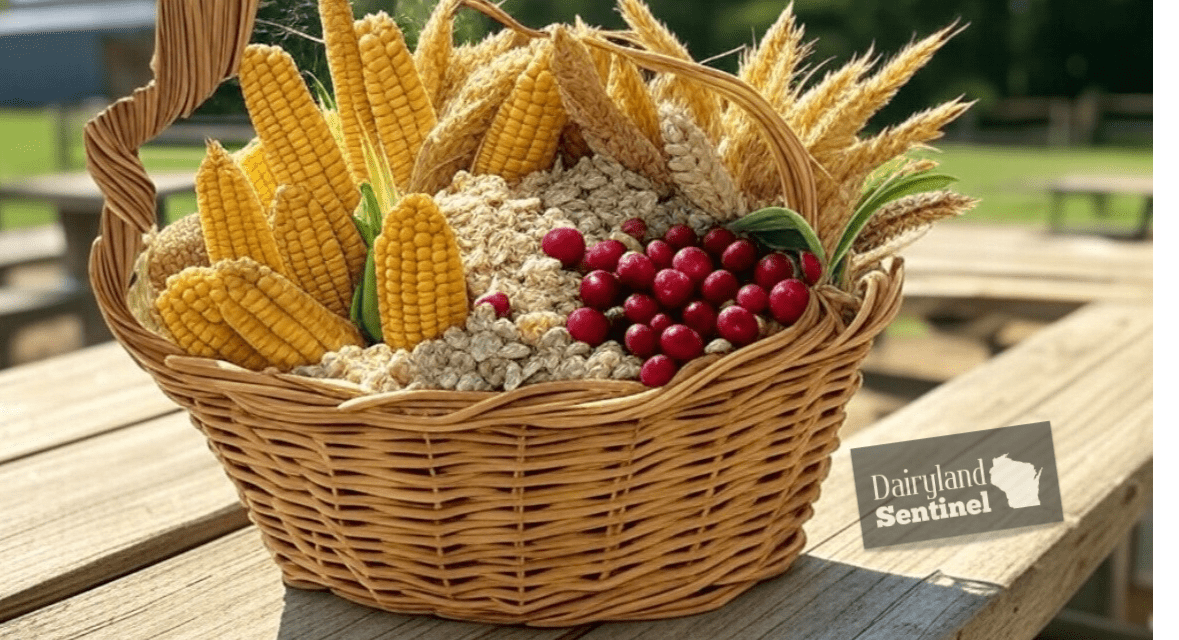Wisconsin’s rolling fields and fertile soils have long fueled an agricultural legacy that stretches back to its early settlers. Known as America’s Dairyland, the state’s reputation extends far beyond milk and cheese. From cranberries bobbing in flooded bogs to corn stretching toward the horizon, Wisconsin’s crop diversity reflects its rich farming tradition and economic might. Drawing from the latest U.S. Department of Agriculture data, here’s a deep dive into the crops that define the Badger State—where they thrive, how they perform, and when they hit the ground or the table.
Corn: The Golden Giant
Corn reigns as Wisconsin’s heavyweight, with 3.9 million acres planted in 2024, according to the USDA’s National Agricultural Statistics Service (NASS). Farmers harvested 3.1 million acres for grain, yielding 181 bushels per acre—a haul totaling 561 million bushels. Valued at $2.8 billion, it’s a cornerstone of the state’s $116.3 billion agricultural economy. Southern Wisconsin, particularly Dane, Rock, and Grant counties, leads production, thanks to deep, loamy soils and a climate that suits this warm-season crop.
Planting kicks off in late April to early May, with harvest running from September through November. Historically, corn surged in the state during the late 19th century as railroads opened export markets. Today, much of the harvest feeds livestock or heads overseas, with Asia and Mexico as key buyers.
Soybeans: The Quiet Powerhouse
Soybeans cover 2.1 million acres statewide, with 2 million acres harvested in 2024, per USDA figures. Yields hit 52 bushels per acre, producing 104 million bushels valued at $1.3 billion. The southeast—counties like Walworth and Racine—dominates, benefiting from flat terrain and proximity to processing hubs.
Farmers plant soybeans in May, harvesting from late September to October. Introduced in the early 20th century, soybeans gained traction after World War II as demand for protein-rich feed and oil soared. Exports lean heavily toward China, though trade fluctuations keep farmers on their toes.
Cranberries: The Red Jewel
Wisconsin leads the nation in cranberry production, harvesting 4.8 million barrels (100 pounds each) from 21,000 acres in 2024. That’s a $156 million crop, with yields averaging 228 barrels per acre. Central Wisconsin, especially Wood, Juneau, and Jackson counties, forms the heart of this industry, where sandy soils and abundant water create ideal bog conditions.
Planting happens in spring, but cranberries are perennial, with vines lasting decades. Harvest runs from late September to October, often with iconic flooding techniques. The crop traces its roots to the 1860s, when settlers tapped native stands. Today, 60% of U.S. cranberries come from Wisconsin, fueling domestic juice and sauce markets while exports target Europe and Asia.
Snap Beans: Processing Pride
Wisconsin tops the charts for snap beans destined for processing, with 63,000 acres harvested in 2024, yielding 8.2 tons per acre. The 517,000-ton crop fetched $62 million. The Fox Valley and areas near Green Bay excel here, thanks to cool summers and irrigation access.
Planting spans May to June, with harvest peaking in August. Snap beans took off in the early 1900s as canning boomed, cementing Wisconsin’s role in the frozen and canned veggie trade. Much of the yield stays domestic, though some reaches Canada and beyond.
Potatoes: A Steady Staple

Potatoes covered 67,000 acres in 2024, producing 36.8 million hundredweight (cwt) at 550 cwt per acre, valued at $441 million. Central Wisconsin’s sandy plains, like Portage and Waushara counties, shine for this tuber, where drainage keeps roots healthy.
Planting starts in April, with harvest from August to October. Potatoes arrived with European immigrants in the 1840s, growing into a commercial force by the 20th century. The state ranks third nationally, supplying fresh markets and processors, with exports to Mexico and Canada.
Oats and Hay: Feed and Forage
Oats spanned 240,000 acres planted, with 110,000 harvested for grain, yielding 67 bushels per acre and 7.37 million bushels worth $27 million. Hay, including alfalfa, hit 2.5 million tons across 1 million acres, valued at $375 million. Northern Wisconsin, with its cooler climes, supports these crops, especially in Marathon and Clark counties.
Oats go in from April to May, harvested July to August, while hay cuts begin in June and stretch into fall. Both trace back to early farming days, feeding dairy herds that define the state’s identity. Exports are minimal—most stays local.
Ginseng: Wisconsin’s Hidden Treasure
Wisconsin stands as the nation’s ginseng powerhouse, producing 95% of U.S. ginseng, with Marathon County at the epicenter. In 2024, the USDA reported 1,200 acres harvested, yielding 1.8 million pounds of dried root, valued at $36 million. The crop thrives in the north-central region’s shaded, well-drained forests, where cool summers and sandy loam mimic its native habitat. Planting occurs in spring, with roots dug up after three to five years, typically in September or October. Cultivated since the early 1900s, ginseng exploded in the 1970s with Asian demand—today, 85% heads to China and Hong Kong for herbal medicine. Yields average 1,500 pounds per acre, a testament to meticulous care in this high-value niche.
Smaller Crops: Cucumbers and Beyond
Beyond Wisconsin’s headline crops, smaller players like cucumbers dot the landscape. In 2024, the USDA pegged cucumber production at 12,000 acres, yielding 120,000 tons, mostly for pickles, valued at $15 million. Grown in central and southern counties like Fond du Lac, they’re planted in May and harvested July through August. Other modest contributors include cherries (3,000 acres, $10 million) in Door County, harvested in July, with tart varieties dominating thanks to the peninsula’s moderating lake breezes; peas (8,000 acres, $8 million) for processing, peaking in June; apples (6,000 acres, $25 million) from Bayfield and Brown counties, harvested September to October; and sweet corn (20,000 acres, $30 million) statewide, picked July to September. Unlike the field corn detailed earlier, which is harvested dry for grain and livestock feed, sweet corn is picked fresh and tender for human consumption. These crops, though outshined by giants like corn or cranberries, round out Wisconsin’s $116.3 billion agricultural lineup, feeding local tables and export markets lwith steady variety..
Historical Threads and Global Reach
Wisconsin’s crop story weaves through time. Corn and oats sustained homesteaders, while cranberries and potatoes bloomed with innovation. The USDA notes that yields have climbed with technology—tractors in the 1920s, hybrids in the 1950s, and precision farming today. Export markets, valued at $3.8 billion annually per the Wisconsin Department of Agriculture, Trade and Consumer Protection, tie the state to the world, from soybean ships to cranberry crates.
The Rhythm of the Seasons
For Wisconsin farmers, the calendar dictates the dance. Spring awakens with planting—corn, soybeans, and oats in April and May. Summer nurtures growth, with hay cutting under June sun. Fall brings the rush—cranberries and snap beans in September, corn and potatoes into November. Each crop, each region, tells a tale of soil, sweat, and a state that keeps feeding the nation and beyond.
Related articles:












